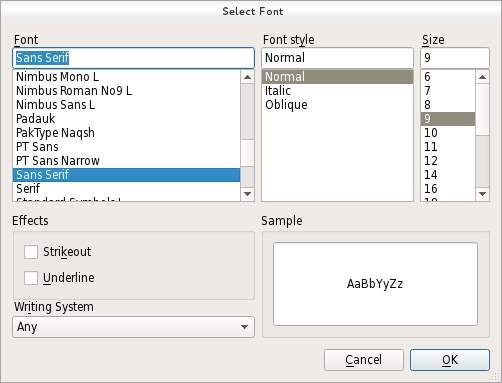QFontDialog¶
The
QFontDialogclass provides a dialog widget for selecting a font. More…

Synopsis¶
Functions¶
def
currentFont()def
open(receiver, member)def
options()def
selectedFont()def
setCurrentFont(font)def
setOption(option[, on=true])def
setOptions(options)def
testOption(option)
Signals¶
def
currentFontChanged(font)def
fontSelected(font)
Static functions¶
Detailed Description¶
A font dialog is created through one of the static
getFont()functions.Examples:
(ok, font) = QFontDialog.getFont(QFont("Helvetica [Cronyx]", 10), self) if ok: # the user clicked OK and font is set to the font the user selected else: # the user canceled the dialog; font is set to the initial # value, in this case Helvetica [Cronyx], 10The dialog can also be used to set a widget’s font directly:
myWidget.setFont(QFontDialog.getFont(0, myWidget.font()))If the user clicks OK the font they chose will be used for myWidget, and if they click Cancel the original font is used.

See also
QFontQFontInfoQFontMetricsQColorDialogQFileDialogStandard Dialogs Example
- class PySide2.QtWidgets.QFontDialog([parent=None])¶
PySide2.QtWidgets.QFontDialog(initial[, parent=None])
- param parent:
- param initial:
Constructs a standard font dialog.
Use
setCurrentFont()to set the initial font attributes.The
parentparameter is passed to theQDialogconstructor.See also
Constructs a standard font dialog with the given
parentand specifiedinitialfont.
- PySide2.QtWidgets.QFontDialog.FontDialogOption¶
This enum specifies various options that affect the look and feel of a font dialog.
For instance, it allows to specify which type of font should be displayed. If none are specified all fonts available will be listed.
Note that the font filtering options might not be supported on some platforms (e.g. Mac). They are always supported by the non native dialog (used on Windows or Linux).
Constant
Description
QFontDialog.NoButtons
Don’t display OK and Cancel buttons. (Useful for “live dialogs”.)
QFontDialog.DontUseNativeDialog
Use Qt’s standard font dialog on the Mac instead of Apple’s native font panel.
QFontDialog.ScalableFonts
Show scalable fonts
QFontDialog.NonScalableFonts
Show non scalable fonts
QFontDialog.MonospacedFonts
Show monospaced fonts
QFontDialog.ProportionalFonts
Show proportional fonts
See also
options
setOption()testOption()
- PySide2.QtWidgets.QFontDialog.currentFont()¶
- Return type:
This property holds the current font of the dialog..
- PySide2.QtWidgets.QFontDialog.currentFontChanged(font)¶
- Parameters:
font –
PySide2.QtGui.QFont
- PySide2.QtWidgets.QFontDialog.fontSelected(font)¶
- Parameters:
font –
PySide2.QtGui.QFont
- static PySide2.QtWidgets.QFontDialog.getFont([parent=None])¶
- Parameters:
parent –
PySide2.QtWidgets.QWidget- Return type:
PyTuple
This is an overloaded function.
Executes a modal font dialog and returns a font.
If the user clicks OK, the selected font is returned. If the user clicks Cancel, the Qt default font is returned.
The dialog is constructed with the given
parent. If theokparameter is not-null, the value it refers to is set to true if the user clicks OK, and false if the user clicks Cancel.Example:
(ok, font) = QFontDialog.getFont(self) if ok: # font is set to the font the user selected else: # the user canceled the dialog; font is set to the default # application font, QApplication.font()
Warning
Do not delete
parentduring the execution of the dialog. If you want to do this, you should create the dialog yourself using one of theQFontDialogconstructors.
- static PySide2.QtWidgets.QFontDialog.getFont(initial[, parent=None[, title=""[, options=QFontDialog.FontDialogOptions()]]])
- Parameters:
initial –
PySide2.QtGui.QFontparent –
PySide2.QtWidgets.QWidgettitle – str
options –
FontDialogOptions
- Return type:
PyTuple
Executes a modal font dialog and returns a font.
If the user clicks OK, the selected font is returned. If the user clicks Cancel, the
initialfont is returned.The dialog is constructed with the given
parentand the options specified inoptions.titleis shown as the window title of the dialog andinitialis the initially selected font. If theokparameter is not-null, the value it refers to is set to true if the user clicks OK, and set to false if the user clicks Cancel.Examples:
(ok, font) = QFontDialog.getFont(QFont("Times", 12), self) if ok: # font is set to the font the user selected else: # the user canceled the dialog; font is set to the initial # value, in this case Times, 12.
The dialog can also be used to set a widget’s font directly:
myWidget.setFont(QFontDialog.getFont(0, myWidget.font()))
In this example, if the user clicks OK the font they chose will be used, and if they click Cancel the original font is used.
Warning
Do not delete
parentduring the execution of the dialog. If you want to do this, you should create the dialog yourself using one of theQFontDialogconstructors.
- PySide2.QtWidgets.QFontDialog.open(receiver, member)¶
- Parameters:
receiver –
PySide2.QtCore.QObjectmember – str
Opens the dialog and connects its
fontSelected()signal to the slot specified byreceiverandmember.The signal will be disconnected from the slot when the dialog is closed.
- PySide2.QtWidgets.QFontDialog.options()¶
- Return type:
FontDialogOptions
This property holds the various options that affect the look and feel of the dialog.
By default, all options are disabled.
Options should be set before showing the dialog. Setting them while the dialog is visible is not guaranteed to have an immediate effect on the dialog (depending on the option and on the platform).
See also
- PySide2.QtWidgets.QFontDialog.selectedFont()¶
- Return type:
Returns the font that the user selected by clicking the OK or equivalent button.
Note
This font is not always the same as the font held by the
currentFontproperty since the user can choose different fonts before finally selecting the one to use.
- PySide2.QtWidgets.QFontDialog.setCurrentFont(font)¶
- Parameters:
font –
PySide2.QtGui.QFont
This property holds the current font of the dialog..
- PySide2.QtWidgets.QFontDialog.setOption(option[, on=true])¶
- Parameters:
option –
FontDialogOptionon – bool
Sets the given
optionto be enabled ifonis true; otherwise, clears the givenoption.See also
options
testOption()
- PySide2.QtWidgets.QFontDialog.setOptions(options)¶
- Parameters:
options –
FontDialogOptions
This property holds the various options that affect the look and feel of the dialog.
By default, all options are disabled.
Options should be set before showing the dialog. Setting them while the dialog is visible is not guaranteed to have an immediate effect on the dialog (depending on the option and on the platform).
See also
- PySide2.QtWidgets.QFontDialog.testOption(option)¶
- Parameters:
option –
FontDialogOption- Return type:
bool
Returns
trueif the givenoptionis enabled; otherwise, returns false.See also
options
setOption()
© 2022 The Qt Company Ltd. Documentation contributions included herein are the copyrights of their respective owners. The documentation provided herein is licensed under the terms of the GNU Free Documentation License version 1.3 as published by the Free Software Foundation. Qt and respective logos are trademarks of The Qt Company Ltd. in Finland and/or other countries worldwide. All other trademarks are property of their respective owners.
